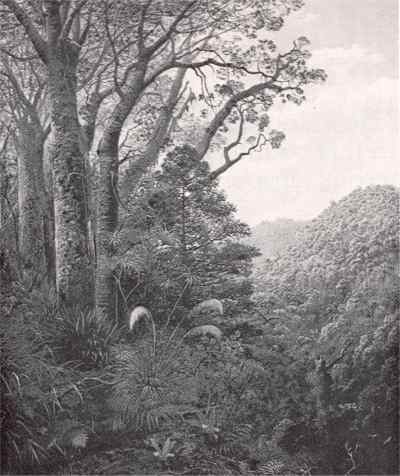Book review
Charles Blomfield: His Life and Times by Muriel Williams
published by Hodder & Stoughton, Auckland, 1979
Pictures of Southern New Zealand by Roger Collins
published by John Mclndoe, Dunedin, 1979
Reviewed by MICHAEL DUNN
Charles Blomfield is known to most students of New Zealand landscape painting as the artist who painted the Pink and White Terraces. Of recent years his saleroom reputation has outstripped his artistic one - perhaps because of his almost production line method of repeating subjects that sold well. A chance to make a fresh assessment of Blomfield comes with the November launching of a handsome volume on the painter by Muriel Williams, his grand-daughter.
The book has many colour reproductions of the artist's works: most, presumably, from private collections, though this cannot be established satisfactorily owing to the fact that, curiously, no locations are given for the works. The plates, spread throughout the text, show that Blomfield was a more varied artist than is often assumed. Apart from the Terrace pictures, there are lake and alpine views, as well as depictions of scenic attractions, such as Mitre Peak. He painted some impressive bush scenes like the Kauris at Thames, reproduced here. And one of the surprises is Blomfield's Tarawera Eruption viewed from the village of Waitangi, known to tourists through a post-card in lurid colour - a card which I remember finding in a shop at the Buried Village. This work (a striking New Zealand example of the Sublime in landscape, with lurid red sky, erupting volcanoes and molten lava descending on fleeing villagers) is shown to be based on a lost picture by Blomfield that was popularised by a colour lithograph.

CHARLES BLOMFIELD
Kauris at Thames 1915
oil on canvas, 863 x 711 mm.
Unfortunately for the specialist, this book does not run to any art historical treatment of the paintings, so that many important aspects of Blomfield's art remain to be considered.
On the credit side, Muriel Williams has made extensive use of letters, journals and contemporary accounts of the artist, to give an authentic feeling to the text. Blomfield's journal of his visit to the thermal areas in 1875-76 is a delight to read. It is full of chatty information about the joys and hardships of the travelling artist. An entry of December 27 reads: 'Morning wet, tent wet, everything wet... The native grass holds the water like a sponge. We were soon as wet about the legs as if we had waded through a creek.' In addition, the letters written to his' wife convey sentiments reminiscent of a romantic novel: 'Dearest of Loves. As soon as one letter is posted I begin another. I went into Ohinemutu today and got your loving epistle and posted one to you. ..' With material of this type the book cannot fail to enjoy a wide, popular readership.
Hodder and Stoughton have taken great care with the production of this book. The design, by John Booth, is tasteful, and sets the period in a way that helps both the text and the plates.
By comparison, Roger Collins's new book Pictures of Southern New Zealand seems to be of slighter substance. It is primarily a book of reproductions: seventy-seven in all, depicting scenes in Otago and further South. All of these pre-date 1900 and lend a documentary value to the book. The text is minimal. In fact, the introduction, of two brief pages, is so short that it cannot fail to puzzle the prospective buyer, who may well feel the need for more guidance to the selection. In addition, there are notes on the artists at the back of the book that provide biographical information and a little bibliography. These entries vary from the substantial for example on Laurence William Wilson - to barely adequate - for example the very scrappy entry on john Kinder.
The selection of plates is varied and interesting. Major pictures by artists such as Von Guerard are mixed with sketches, such as Walter Mantell's Haunui and Lignite Fall, Mataura. This gives a balance of artistically significant works and those of purely historical interest.
Judging by the short entries below each plate, Roger Collins was attempting to provide a little information for historians of the area and those interested in nineteenth century landscape. It is doubtful, however, whether sentences such as the one beneath Von Guerard's Milford Sound, New Zealand 1877, are going to satisfy even the general reader: 'Von Guerard's sombre view of Milford Sound proposes a dramatic and heroic interpretation of a scene which Gully and Richmond painted in a lighter, brighter mood'.
The plates vary in quality from good to poor. Several of the pencil drawings appear so faint and blurry as to be unacceptable in a book of this kind (examples are page 57, Andrew Hamilton; and pages 52-53, William Mathew Hodgkins). Even black-and-white plates of paintings, such as that on page 15, Kinder's well-known Waikouaiti, Dunedin, 1873, can lack definition and clarity of tone, and be marred by spots and marks not to be found on the original works. Despite these flaws, the book is a welcome addition to the growing body of works on New Zealand landscape, and includes items not to my knowledge previously reproduced.
